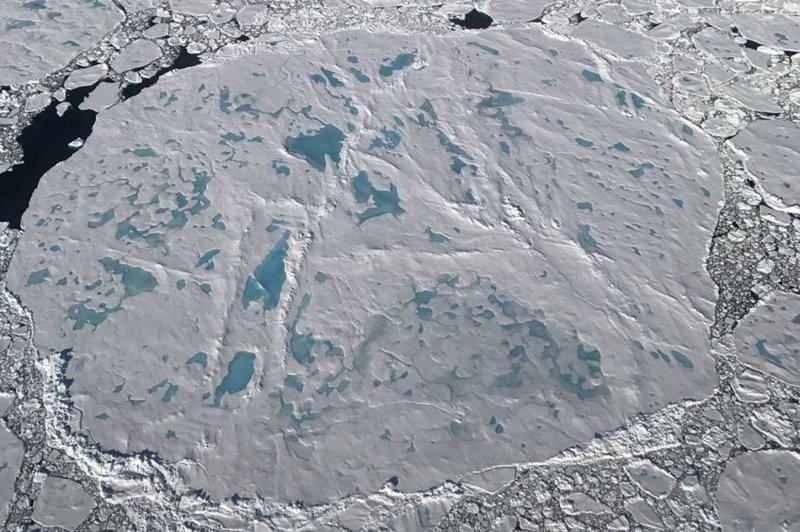
Researchers say that rising ice melt -- melt ponds and smaller floes are pictured in northern Greenland in August 2017 -- and greenhouse gases on Earth, caused by humans, are driving climate change.
File Photo by Nathan Kurtz/NASA | License Photo
Nov. 10 (UPI) -- Rising greenhouse gas concentrations in the atmosphere and the melting of the polar ice sheets are the main drivers of climate change, according to an analysis published Wednesday by the journal Nature.
There has been a general warming trend over the past 10,000 years, and the magnitude and rate of warming over the past 150 years far surpasses the magnitude and rate of changes over the past 24,000 years, the data showed.
The findings, which are based on reconstructions of the Earth's climate since the last ice age, about 24,000 years ago, also show the adverse effects of human activity on the climate, given that the past 150 years coincides with the rise of large-scale industry globally, the researchers said.
"This reconstruction suggests that current temperatures are unprecedented in 24,000 years," study co-author Jessica Tierney said in a press release.
"[It] also suggests that the speed of human-caused global warming is faster than anything we've seen in that same time," said Tierney, an associate professor of geosciences at the University of Arizona in Tucson.
A study published earlier this year noted that rising greenhouse gas concentrations in the Artic are threatening the ozone layer in the region and contributing to ice sheet melt.
For this study, the researchers created maps of global temperature changes for every 200-year interval going back 24,000 years by combining two independent datasets -- temperature data from marine sediments and computer simulations of climate.
The researchers analyzed the chemical signatures of marine sediments to get information about past temperatures.
Because temperature changes over time can affect the chemistry of a long-dead animal's shell, scientists can use those measurements to estimate temperature in an area.
It's not a perfect thermometer, but it's a starting point, the researchers said.
In addition, the computer-simulated climate models provided temperature data based on the researchers' best understanding of the physics of the climate system, which also isn't perfect, they said.
However, by combining the methods -- a process called data assimilation that is also used frequently in weather forecasting -- they were able to harness the strengths of both.
"To forecast the weather, meteorologists start with a model that reflects current weather," said Tierney, who also contributed to the Intergovernmental Panel on Climate Change, released in October.
"[They] then add in observations such as temperature, pressure, humidity, wind direction and so on to create an updated forecast," she said.
Nov. 10 (UPI) -- Rising greenhouse gas concentrations in the atmosphere and the melting of the polar ice sheets are the main drivers of climate change, according to an analysis published Wednesday by the journal Nature.
There has been a general warming trend over the past 10,000 years, and the magnitude and rate of warming over the past 150 years far surpasses the magnitude and rate of changes over the past 24,000 years, the data showed.
The findings, which are based on reconstructions of the Earth's climate since the last ice age, about 24,000 years ago, also show the adverse effects of human activity on the climate, given that the past 150 years coincides with the rise of large-scale industry globally, the researchers said.
"This reconstruction suggests that current temperatures are unprecedented in 24,000 years," study co-author Jessica Tierney said in a press release.
"[It] also suggests that the speed of human-caused global warming is faster than anything we've seen in that same time," said Tierney, an associate professor of geosciences at the University of Arizona in Tucson.
A study published earlier this year noted that rising greenhouse gas concentrations in the Artic are threatening the ozone layer in the region and contributing to ice sheet melt.
For this study, the researchers created maps of global temperature changes for every 200-year interval going back 24,000 years by combining two independent datasets -- temperature data from marine sediments and computer simulations of climate.
The researchers analyzed the chemical signatures of marine sediments to get information about past temperatures.
Because temperature changes over time can affect the chemistry of a long-dead animal's shell, scientists can use those measurements to estimate temperature in an area.
It's not a perfect thermometer, but it's a starting point, the researchers said.
In addition, the computer-simulated climate models provided temperature data based on the researchers' best understanding of the physics of the climate system, which also isn't perfect, they said.
However, by combining the methods -- a process called data assimilation that is also used frequently in weather forecasting -- they were able to harness the strengths of both.
"To forecast the weather, meteorologists start with a model that reflects current weather," said Tierney, who also contributed to the Intergovernmental Panel on Climate Change, released in October.
"[They] then add in observations such as temperature, pressure, humidity, wind direction and so on to create an updated forecast," she said.
In future studies, the researchers plan to apply their method to investigate climate changes even farther in the past, they said.
"With this method, we are able to leverage the relative merits of each of these unique datasets to generate observationally constrained, dynamically consistent and spatially complete reconstructions of past climate change," study co-author Matthew Osman said in a press release.
"The fact that we're today so far out of bounds of what we might consider normal is cause for alarm and should be surprising to everybody," said Osman, a geosciences postdoctoral researcher at the University of Arizona.
No comments:
Post a Comment